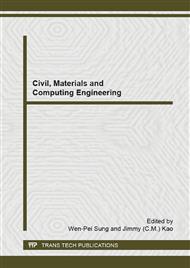[1]
Cai Wei and Lou Qinghua, Study of Error Control in Online Marking of Compositions in College Entrance Examination, entrance exam in Hubei, No. 12, 2008, pp.
Google Scholar
[2]
Zhang Changying, The Methods and Implementation of Error Control in Online Marking of the University Entrance Exam, Exploration of higher education, No. 3, 2003, pp.77-79.
Google Scholar
[3]
Hu Tang, The research and practice of the subjective questions marking error control in the university entrance exam, J. of Henan Univ. (Soc. Sci. ), Vol. 36, No. 4, Jul. 1996, pp.31-35.
Google Scholar
[4]
Fan Peng and Zhang Jinghua, The study of error control of online marking in arge-scale standardized tests, China Education of Light Industry, No. 1, 2012, pp.88-91.
Google Scholar
[5]
Zhao Shiming, Error Control in the Paper-free Scoring for Essays, Journal of Henan University (Social Science), Vol. 47, No. 1, 2007, pp.155-158.
Google Scholar
[6]
Lou Qinghua, A Research in Scoring Error Control of the College Entrance Examination Composition Papers, Zhejiang Normal Univ., Hangzhou, China, (2007).
Google Scholar
[7]
G. Paun. A quick introduction to membrane computing, The Journal of Logic and Algebraic Programming. J., Vol. 79, p.291–294, (2010).
Google Scholar
[8]
R. Freund, M. Oswald and G. Paun. Catalytic and Purely Catalytic P system and P Automata: Control Mechnisms for Obtaining Computational Completeness. 14th International Conference, CMC14, pp.317-320, (2013).
DOI: 10.3233/fi-2015-1144
Google Scholar
[9]
R. Freund, L. Kari, M. Oswald and P. Sosik. Computationally universal P systems without priorities: two catalysts are sufficient. Theoretical Computer Science. J, Vol. 330, No. 2, pp.251-266, (2005).
DOI: 10.1016/j.tcs.2004.06.029
Google Scholar
[10]
G. Paun, G. Rozenberg and A. Salomaa. The Oxford Handbook of Membrane Computing. Oxford University Press, (2010).
Google Scholar
[11]
G. Paun and R. Paun, Membrane computing and economics: Numerical P systems. Fundamenta Informaticae. J, Vol. 73, No. 1, pp.213-227, (2006).
Google Scholar
[12]
A. Pavel, O. Arsene and C. Buiu. Enzymatic numerical P systems-a new class of membrane computing systems. Bio-Inspired Computing: Theories and Applications (BIC-TA), 2010 IEEE Fifth International Conference on. IEEE, pp.1331-1336, (2010).
DOI: 10.1109/bicta.2010.5645071
Google Scholar
[13]
R. Barbuti, A. Maggiolo-Schettini, P. Milazzo, G. Pardini and L. Tesei. Spatial P systems. Natural Computing. J, Vol. 10, No. 1, pp.3-16, (2011).
DOI: 10.1007/s11047-010-9187-z
Google Scholar
[14]
S. Verlan. Using the Formal Framework for P Systems. 14th International Conference, CMC14, pp.37-38, (2013).
Google Scholar
[15]
M. Gheorghe and F. Ipate. Kernel P Systems - A Survey. 14th International Conference, CMC14, pp.9-10, (2013).
Google Scholar
[16]
Z. Gazdag. Solving SAT by P Systems with Active Membranes in Linear Time in the Number of Variables. 14th International Conference, CMC14, pp.167-180, (2013).
Google Scholar
[17]
L. Cienciala, L. Ciencialova and M. Langer. Modelling of Surface Runoff using 2D P colonies. 14th International Conference, CMC14, pp.81-94, (2013).
Google Scholar
[18]
I.T. Banu-Demergian and G. Stefanescu. The Geometric Membrane Structure of Finite Interactive Systems Scenarios. 14th International Conference, CMC14, pp.63-80, (2013).
Google Scholar
[19]
S. Jie and X. Y. Liu. Density-Based Clustering by P System with Active Membranes on Commodity Recommendation in E-commerce Websites. WSEAS Transactions on Computers, v 13, pp.20-33, (2014).
Google Scholar
[20]
G. X. Zhang and L. Q. Pan, A survey of membrane computing as a new branch of natural computing, Chinese journal of computers, Vol. 33, No. 2, 2010, pp.208-214.
DOI: 10.3724/sp.j.1016.2010.00208
Google Scholar
[21]
G. Paun, Computing with Membranes, Journal of Computer and System Sciences, Vol. 61, No. 1, 2000, pp.108-143.
Google Scholar
[22]
T. Song, Evaluation System and Model of Markers marking quality on Online marking, CAT. Dissertation, Dept. Computer Application Technology, Henan Univ., Hnan, China, (2010).
Google Scholar
[23]
P. Fan and J.H. Zhang, The study of error control of online marking in arge-scale standardized tests, China Education of Light Industry, No. 1, 2012, pp.88-91.
Google Scholar


